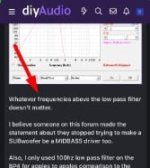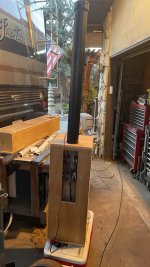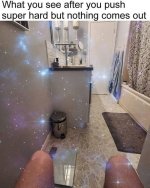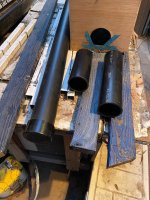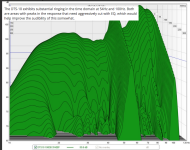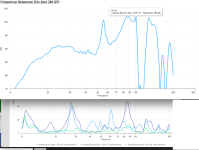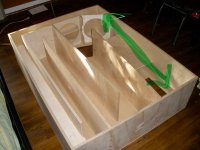I like to SEE what the enclosure will look like when built in HR.
Now of course, 9 out of 10 times, the port will be inside the vented chamber. Basically, HR provides a blow thru type pic for pickup trucks.


Now of course, 9 out of 10 times, the port will be inside the vented chamber. Basically, HR provides a blow thru type pic for pickup trucks.
Are you looking at the ZR series? These are for when very lil space is available for a speaker box and need a lot of power to work well. The ZR and ZXI series 12s that I have really needs to be hung off a good 1kw dynamic power. All the published T/S specs again contain an anomaly related to VC config, and all sims based off them are unreliable. Last time I spoke to DS18 tech, they said that all the DVC drivers are getting retested, but I haven't checked to see if that has been done yetWell the Dayton Audio RSS390HO-4 is backordered until 6-27-2025 so I'll need a different sub that will work in that sealed cabinet as I want to go ahead and get these subs done while I have the money to do so.
Saw this one.
https://www.parts-express.com/DS18-...rbon-Fiber-Duat-Cap-4-Ohm-294-8072?quantity=1
Really have to buy one and run it through a proper breaking in and a run through DATS to get the correct values to make a proper use of them
Aside from the backordered Dayton Audio sub, there any 15" subs that have an F3 of 30Hz in a sealed box?
Any 15" driver can have a f3 of 30hz if the enclosure is big enough. You might be able to apply full power to the driver due to xmax, but you'll get your 30hz.
Gross conceptual error
Why? If it did, then there wouldn't be 24/36/48db filter slopes.
Frequencies above a midbass or midrange driver's low pass filter don't matter, so why should it matter to a SUBwoofer?
What does that huge honk/howl spike actually sound like before/after you retard it with a ‘crossover’? You’re just looking at a frequency response and not the crazy/measured ‘decay’ funk of reality?
The huge acoustical issues in the tapped horns, pipes and paraflexes need more attention than a software model suggests. Otherwise we wouldn’t be tweaking the affective resonator lengths, offsets and adding absorbers tubes , etc? (The super long pipe in the pick is a joke, but the other size (when trimmed/tuned, worked fantastic to fix the issues that otherwise made that box completely useless as a subwoofer, especially ‘near field’ or in a car )
I wonder what the ‘aperture’ in the ‘keystone’ exit (or similar ways to ‘damp’ down some craziness?) might do to help these things as well?
The huge acoustical issues in the tapped horns, pipes and paraflexes need more attention than a software model suggests. Otherwise we wouldn’t be tweaking the affective resonator lengths, offsets and adding absorbers tubes , etc? (The super long pipe in the pick is a joke, but the other size (when trimmed/tuned, worked fantastic to fix the issues that otherwise made that box completely useless as a subwoofer, especially ‘near field’ or in a car )
I wonder what the ‘aperture’ in the ‘keystone’ exit (or similar ways to ‘damp’ down some craziness?) might do to help these things as well?
Attachments
Last edited:
Why? If it did, then there wouldn't be 24/36/48db filter slopes.
Frequencies above a midbass or midrange driver's low pass filter don't matter, so why should it matter to a SUBwoofer?
I think some ‘more’ of the issue is your subwoofer is a lot louder when it makes these noises (unexpectedly) and it sounds very awkward to most people (at some point, nobody cares in car audio if they’re just listening to a gigantic amount of sheet metal tambourine is going crazy regardless ?)
if youre gonna make a 'subwoofer', then go all in?!? what good is that gigantic resonant spike created by the high tuned chamber/vent and 'slight' loading of the driver at 'subwoofer frequencies?
You have it backwards, the sealed cabinet has no resonator to amplify any harmonic distortion the driver produces, the peaky bandpass does.Sealed cabinets are distortion monsters.
An electrical low pass filter won't have any effect on the harmonic distortion components the BP4 peak both amplifies by the amount of the peak, and allows to ring on.No ONE listens to a SUBwoofer without a low pass filter, hence...
Whatever frequencies above the low pass filter doesn't matter.
Also, I only used 100hz low pass filter on the BP4 for apples to apples comparison to the sealed enclosure.
https://data-bass.com/systems/5b11c00551412e00047d6695
This effect can be seen in the frequency, distortion and time decay response of the DTS-10 bandpass:
The 2nd harmonic distortion peak at 27Hz, half the frequency of the 54Hz ringing peak is most obvious.
The highest amplitude 2nd, 3rd and 4th harmonic distortion peaks occur at divisions of 2, 3 and 4 of the highest frequency response/ringing peaks.
As a rule, they rule in amplifying speaker distortion 😉BANDPASS RULES!
Art
Attachments
I wonder what is contributing the two impedance peaks to almost overlap here? In my ‘paraflex’ experiments, this is where an audible phase discontinuity existed because the resonators didnt hook up at 3:1 (length/tuning frequency) ‘perfectly’…
In this ‘series’ design it’s where the crazy 54 hz spike exists. As if two resonators are contributing to the same resonace or? 🤷🏼
In this ‘series’ design it’s where the crazy 54 hz spike exists. As if two resonators are contributing to the same resonace or? 🤷🏼
Attachments
I like BP4 subwoofers a lot, but you need to design them such, that the lowpass slope behaves like a 12dB/octave filter and with minimal spikes higher up. Can be done. I have a Dayton DVC 8" in BP4 that behaves well, so I just cut the higher frequencies at 250Hz, while the response drops nicely after 100Hz with a"natural" 12dB rolloff. The exemple from BP1Fanatic and weltersys are horrible in my ears. The peaks will shine through, even when using a steep crossover.
The little impedance peak is at 56Hz, ~four times the low Fb of 14.25.I wonder what is contributing the two impedance peaks to almost overlap here?
In this ‘series’ design it’s where the crazy 54 hz spike exists. As if two resonators are contributing to the same resonace or? 🤷🏼
At any rate, Tube Radio has already made it clear he doesn't want a peaky resonant response last Thursday.Oh ok then sealed is what I want for the flattest response.
Art
If I knew how to work with wood to where what I do actually looks presentable I'd look into other designs and then selecting a driver wouldn't be so difficult.
That curve gives "1 note bass" in a car. I would NEVER build YOUR enclosure.View attachment 1422110
if youre gonna make a 'subwoofer', then go all in?!? what good is that gigantic resonant spike created by the high tuned chamber/vent and 'slight' loading of the driver at 'subwoofer frequencies?
YOU need learn about transfer function/cabin gain.
You have it backwards, the sealed cabinet has no resonator to amplify any harmonic distortion the driver produces, the peaky bandpass does.
An electrical low pass filter won't have any effect on the harmonic distortion components the BP4 peak both amplifies by the amount of the peak, and allows to ring on.
https://data-bass.com/systems/5b11c00551412e00047d6695
This effect can be seen in the frequency, distortion and time decay response of the DTS-10 bandpass:
"Listening to the DTS-10 does not sound like you would expect from looking at the distortion performance. It is not as obvious as you would believe. Between 13-26Hz octave the DTS-10 is exceptionally clean and high output and has a different signature than other systems."
I rest my case.
Before the subjective portion of the DTS-10 "Distortion Results" review you quoted, Josh Ricci wrote:I rest my case.
"There are many large impedance fluctuations, excursion fluctuations and changes in loading on the drivers...Some areas have the distortion harmonics greatly amplified by the loading of the tapped horn enclosure. For example at 27Hz the 2nd harmonic is boosted by the 54Hz peak and the 3rd harmonic also gets amplified acoustically at 81Hz."
Now that it should be obvious to you that the BP acoustically amplifies harmonic distortion by a great amount, what is your case?
Art
Last edited:
I suppose that type of enclosure might be fine for someone wanting to just go loud as in car audio applications where maximum SPL is desired.
That curve gives "1 note bass" in a car. I would NEVER build YOUR enclosure.
YOU need learn about transfer function/cabin gain.
You created/suggested an obsurd resonace spike at 144 hz so I just extended the resonator length further to create an additional resonace (in the subwoofer bandwidth ) much lower.
Both ideas are ridiculous by anyone’s ’standard’ . Have you actually built/listened to the type of box/response/XO/eq that you suggested? What did it sound like ?
- Home
- Loudspeakers
- Subwoofers
- Subwoofer build
